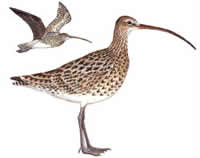Curlew (Numenius arquata)

Description
The curlew is the largest wader in Europe, and has a distinctive long down-curved bill. Their plumage is mostly brown on the upper body with streaks on the neck and underparts, grading to white below the tail. The white rump is conspicuous in flight. Both sexes and the juveniles look alike. Its call is a very distinctive "cooo-leeee" which gives the bird its common name.
Behaviour
Curlews spend most of the winter months in estuaries and mud-flats, feeding on small marine worms, shrimps and shore-crabs. In early spring the birds move inland to breed in upland blanket bogs, lowland raised bogs and rough pasture. Outside the breeding season they are frequently seen in small flocks, often in the company of other waders.
Breeding
During courtship, the male rises steeply into the air and begins singing a crescendo of notes as he glides back down to the ground again on quivering wings. The nest is a shallow depression on the ground, lined with a few plant fibres. The female usually lays four green and brown eggs from March to May and the young birds leave the nest with their parents soon after hatching. They can fly at about 5 or 6 weeks


